On my first trip to Sicily, I happened to visit the Siracusa Greek Theatre on the very day it was celebrating its anniversary as a UNESCO World Heritage site. The sheer size and beauty of the ancient theatre, with its stone seats carved into the hillside, immediately caught my attention. Standing there, I couldn't help but think about the thousands of years of history within those walls, from classical Greek dramas to contemporary performances. As I took in the breathtaking views of the city and the sea, I realized how these historic sites connect us to the past in a profound way.
History of Siracusa Greek Theatre
The Siracusa Greek Theatre, built in the 5th century BC, is a testament to ancient Greek architectural skill and cultural richness. As I walked through its remnants, I was struck by the history that had taken place here. Situated on Temenite Hill, the theater was more than just a stage for performances; it was a communal space. From the top, you can see the city of Siracusa and catch a glimpse of the sea, a view that must have been breathtaking for its ancient audience.
I thought about the lively scenes of ancient Greek society, the performances, and the powerful speeches that echoed through the amphitheater. This wasn't just a space for the elite; it was a democratic gathering place where citizens came to watch dramas that delved into themes of human freedom, fate, and morality. The stones seemed to tell stories, linking me to a culture that valued both art and intellect.
Standing there, I felt a deep appreciation for the cultural legacy of the ancient Greeks. The Siracusa Greek Theatre isn't just an archaeological site; it's a lasting symbol of human creativity and community spirit.
Architecture and Design

As I wandered through the ruins, I marveled at the clever architecture and careful design of the Siracusa Greek Theatre. The teatro greco di Siracusa stands as a testament to the ancient Greeks' unmatched skill in merging functionality with beauty. The semi-circular seating, carved directly into the hillside, forms a natural amphitheater that enhances sound superbly.
The design is both practical and beautiful. The large stage, or orchestra, was crafted to host elaborate performances, ensuring that every audience member had a clear view. The tiered seating provided a fair viewing experience, allowing people from all social classes to enjoy the shows.
The seating area, known as the cavea, is carved into the rock, highlighting the Greeks' precision in stonework. The skene, the building behind the stage, served as a dressing room and storage space. The diazoma, a horizontal walkway, divides the seating tiers and allows easy movement. The proscenium, the front part of the stage, is both decorative and functional.
Thinking about the teatro greco di Siracusa, I felt deep admiration for the ancient Greeks' ability to create such lasting and inspiring spaces. It's a place where history, art, and architecture come together seamlessly.
Key Performances and Events
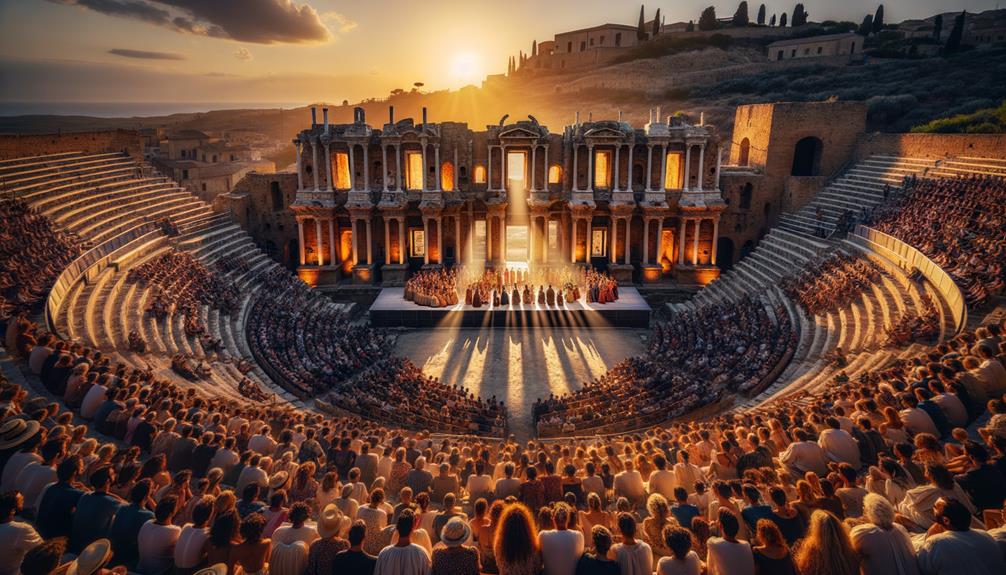
For centuries, the Siracusa Greek Theatre has been a stage for countless unforgettable performances and events, leaving a lasting impact on both ancient and modern cultures. As you walk through its ancient stone seats, you can't help but feel the history around you, where Greek tragedies and comedies once held audiences spellbound. The scale of the Syracuse Greek Theater is impressive, and it's amazing to think that it continues to host performances today.
One of the most memorable moments for me was watching a modern take on Aeschylus' 'The Persians.' The powerful acting and the theater's incredible acoustics transported me back to a time when it was a center for Greek culture and drama. Even now, the theater is a lively cultural venue, showcasing everything from classical plays to modern concerts.
Nearby, the Ear of Dionysus adds to the intrigue. This limestone cave, known for its unique acoustics, was allegedly used by Dionysius the Tyrant to eavesdrop on prisoners. The blend of history and mythology around the Syracuse Greek Theater makes every visit a vivid journey through time, where the past and present seamlessly come together.
Tour Options and Packages

Reflecting on the rich history and captivating performances at the Siracusa Greek Theatre, it struck me that different tour options might deepen one's appreciation of this ancient site. Located within the Neapolis Archaeological Park, the theatre offers a fascinating journey through time, made more insightful with the right tour package.
A 1.5-hour private guided tour is available for small groups of up to 15 people. Starting at $97.51, this tour provides a close-up look at the ruins, including the Altar of Hieron and the intriguing Ear of Dionysus cave. With morning or afternoon departures, it's easy to fit into any itinerary.
For those looking to see more, there are day tours from Taormina and Catania. A 10-hour tour from Taormina, priced between $59.92 and $294.16, includes stops at Syracuse, Ortigia, and Noto, offering a blend of culture and convenience. Private day trips are another option, featuring a personal driver and tailored exploration of Ortigia and Neapolis.
Some tours also offer skip-the-line entrance tickets, starting at $116.57 for an 8-hour tour, making the experience smooth and hassle-free.
- Private guided 1.5-hour tour
- Day tours from Taormina and Catania
- Private day trips with a personal driver
- Skip-the-line entrance tickets
These choices cater to various interests and provide a deeper understanding of this UNESCO World Heritage site.
Ticket Prices and Discounts

When you're gearing up for a visit to the Siracusa Greek Theatre, knowing the ticket prices and available discounts can really help you plan your trip. Tickets start at $26.19, but the price can change depending on the type of tour you choose. Whether you prefer a simple walk-through or a more detailed private guided tour, options range from $25.66 to $116.57 for an 8-hour experience.
If you live in Syracuse or nearby, you can get a ticket for just €20, but you'll have to buy it at the ticket office. Students can score Sector S seats for €25. For larger groups, there's a special deal—every 20 people get a discount, and on certain days, tickets are priced at €28.
Subscriptions can offer more flexibility and savings. Buying multiple tickets or subscribing to several performances can reduce your costs, especially if you're interested in attending a third performance.
The Siracusa Greek Theatre has something for everyone, whether you're a local or just visiting, making it easier to budget for this cultural experience.
Best Time to Visit
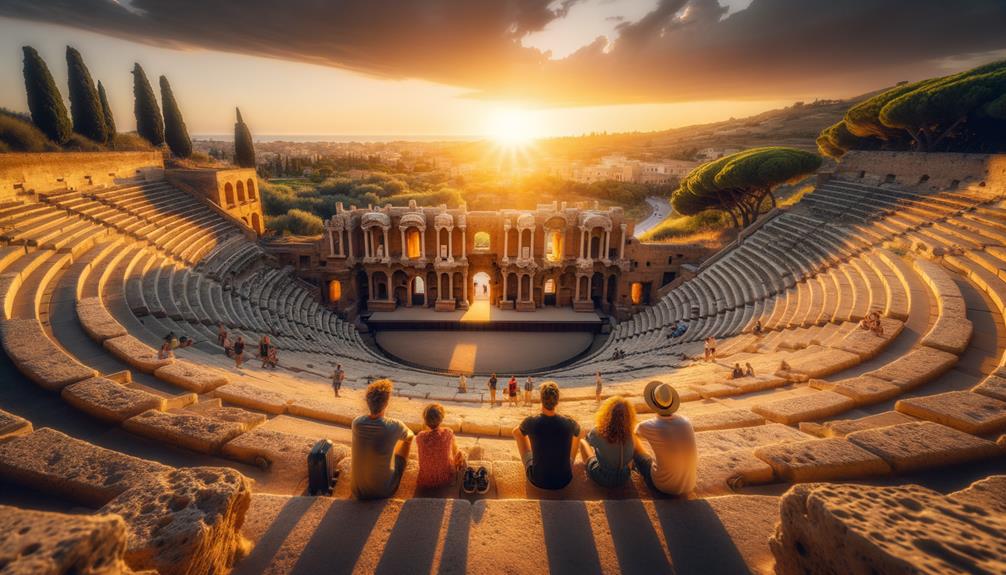
The best time to visit the Siracusa Greek Theatre really depends on a few things. The weather changes with the seasons and can have a big impact on your visit, and the busiest tourist times bring both excitement and crowds. Special events, especially the classical plays, offer a unique charm that's tough to beat.
Seasonal Weather Conditions
If you're planning a visit to the Siracusa Greek Theatre, spring is a fantastic time to go. The weather is pleasant, and the flowers in bloom add a splash of color to the ancient ruins. The mild temperatures and fresh air make it the perfect season for wandering through this historic site.
Walking through the theatre in spring feels like stepping back in time, with a gentle breeze and warm sunshine enhancing the experience. The season brings a sense of renewal that makes the visit even more special.
- Comfortable temperatures: Perfect for leisurely exploration.
- Flowers in bloom: Adding vibrant colors to the old stone structures.
- Longer days: Giving you more time to appreciate the beauty and history.
- Smaller crowds: Allowing for a more intimate and reflective experience.
Thinking back on my visit, I realized how much the spring weather added to the charm of the Siracusa Greek Theatre. The combination of nature's beauty and ancient history made the place truly come alive.
Peak Tourist Periods
Springtime at the Siracusa Greek Theatre offers a peaceful and vibrant experience, but come summer, the place turns into a lively center of activity and cultural events. The busiest time for tourists is in July and August, when the Sicilian sun pushes temperatures over 30°C (86°F). Despite the heat and humidity, the allure of evening classical performances draws large crowds of both tourists and locals. The atmosphere buzzes with excitement and anticipation.
Visiting early in the morning is the best way to avoid crowds and high temperatures. Long lines are common during peak times, so arriving right when the theatre opens can make your visit much more enjoyable. It's also wise to check the calendar for public holidays since these can attract even larger crowds and lead to longer wait times.
The summer performances are the highlight of Sicily's cultural events. Experiencing the magic of the Greek theatre during this period is unforgettable, but be sure to book tickets and tours well in advance to avoid missing out. Each visit feels like stepping into a timeless celebration of history and art.
Special Events Schedule
The Siracusa Greek Theatre's event calendar is packed with classical performances, historical reenactments, and cultural festivals. Planning your visit around these lively events can make your experience even more memorable. Spring and early summer are ideal times to visit, as they coincide with the annual Greek Theatre Festival, where ancient dramas and comedies come to life on stage.
When I visited, I was captivated by the blend of history and art. The ancient city of Siracusa, with its timeless ruins, felt especially vibrant during these events.
- Greek Theatre Festival: Running through May and June, this festival features classical Greek plays.
- Historical Reenactments: Experience key moments from Siracusa's rich past.
- Cultural Festivals: Enjoy local traditions, food, and music.
- Special Concerts: Modern musicians perform in this historically rich setting.
These events not only enhance your theater experience but also offer a deeper connection to the island's heritage. For anyone interested in diving into Siracusa's historical and cultural treasures, timing your visit with these special events is well worth it.
Getting There
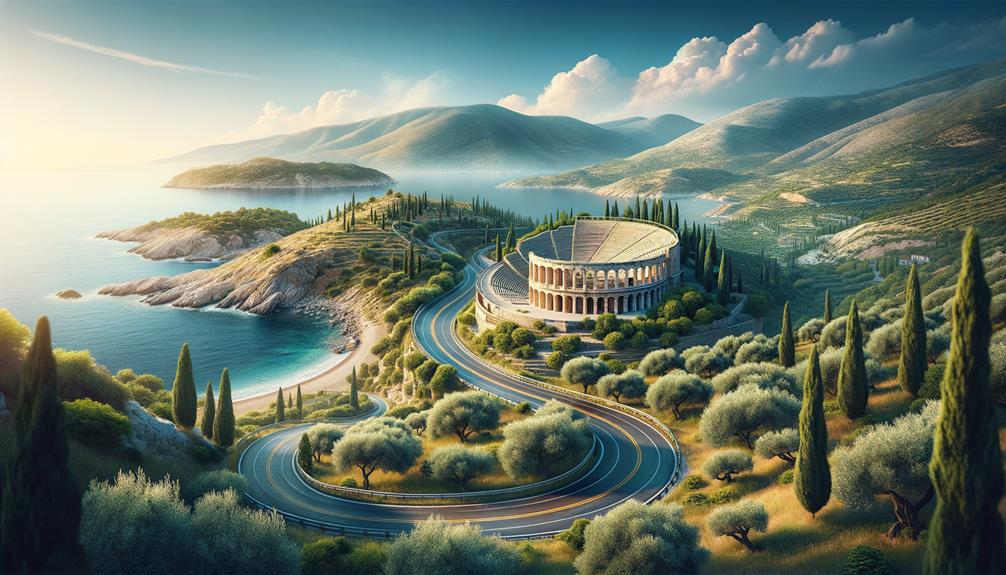
Getting to the Siracusa Greek Theatre is pretty straightforward, no matter where you're coming from. If you're in the city center, a taxi or bus ride will get you there quickly. For a more scenic route, you can walk uphill from Fonte Aretusa. If you're flying in, the Catania-Fontanarossa Airport has good connections to Siracusa, making your trip easy.
Transportation Options Overview
Getting to the Siracusa Greek Theatre is easy, with several transportation options to suit your preferences. Located in the Neapolis Archaeological Park in Siracusa, it's accessible whether you're walking, taking public transport, or driving.
If you enjoy walking, the theatre is about a 20-minute stroll from the Siracusa city center. This gives you a chance to experience the city's vibrant atmosphere on your way.
For those who prefer public transport, there's a convenient bus service from the city center that takes around 10-15 minutes to reach the park. The buses run frequently, making this a hassle-free option.
Taxis are also readily available throughout Siracusa. A quick 10-15 minute ride will get you to the theatre's entrance, offering comfort and convenience, especially if you're short on time or energy.
If you're arriving by train, there's no direct service to the theatre. However, you can get off at the Siracusa railway station and take a bus or taxi from there to complete your trip.
Here's a quick breakdown:
- Walking: 20 minutes from Siracusa city center
- Bus: 10-15 minutes from city center to Neapolis Archaeological Park
- Taxi: 10-15 minutes ride from city center
- Train: Transfer from Siracusa station to bus or taxi
Best Travel Times
If you're planning a visit to the Siracusa Greek Theatre, aim for the early morning hours. This time of day offers a peaceful experience, free from the heat and crowds that gather later. Arriving right as the theatre opens at 9:00 AM, you'll enjoy a gentle sun and a calm atmosphere. This is especially beneficial during the summer when it gets quite hot by midday.
The ideal months to visit are from April to October. The weather is generally mild and sunny, perfect for exploring outdoors. While summer does bring more tourists, starting your day early helps you avoid the rush and enjoy a quieter connection with history.
Here's a quick reference to help plan your trip:
| Factor | Details |
|---|---|
| Best Months to Visit | April to October |
| Theatre Hours | 9:00 AM to 6:00 PM |
| Nearest Airport | Catania-Fontanarossa |
| Travel Time from City | 10-15 minutes by bus or taxi |
Syracuse has something special to offer year-round, but early mornings provide a unique mix of calm and exploration. So, set your alarm and enjoy the freedom of discovering this historic site without the crowds.
Nearby Attractions

Exploring the area around the Siracusa Greek Theatre is like stepping into a living museum. History and culture come alive in every corner. Here are some nearby spots that left a lasting impression on me:
- Ortigia Island: Just a short walk away, this island is full of charming streets, stunning baroque buildings, and bustling markets. Wandering through its narrow lanes, I enjoyed the scent of fresh seafood and the lively local conversations.
- Noto Walking Tour: A quick drive from Siracusa, the town of Noto amazed me with its beautiful baroque architecture. Walking through its golden streets felt like a journey back in time, with each building showcasing incredible craftsmanship.
- Tour of the Neapolis: This archaeological park is packed with ancient ruins. The Roman Amphitheatre, the Altar of Hieron, and the Ear of Dionysius each have their own stories to tell, making the past feel very present.
- Catacombs of San Giovanni: Beneath the city, these early Christian burial sites offer a peaceful and solemn experience. The quiet underground passages made a strong impression on me.
Each of these attractions added a unique layer to my visit, making it an unforgettable experience filled with history and culture.
Visitor Tips
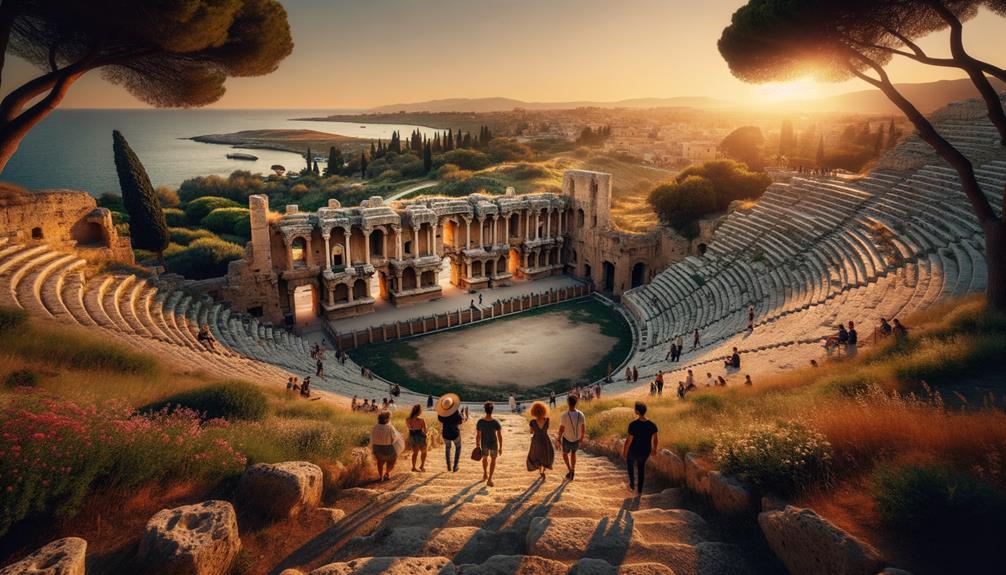
To get the most out of your visit to the Siracusa Greek Theatre, here are some handy tips to ensure you have a great experience and don't miss anything at this UNESCO World Heritage site in beautiful Syracuse.
Try to plan your visit for early morning or late afternoon. This way, you can avoid the midday heat and the crowds, and the softer light is perfect for taking photos.
Make sure to wear comfortable walking shoes. The ancient stones can be uneven, so you'll want to explore without worrying about sore feet.
Don't forget to bring water and a hat. The Sicilian sun can be pretty intense, and it's important to stay hydrated.
It might be worth hiring a local guide. They can share insights and stories that really bring the history of this amazing place to life.
Here's a quick reference table to help you prepare:
| Tip | Reason |
|---|---|
| Visit early/late | Avoid heat and crowds |
| Comfortable shoes | Uneven ancient stones |
| Bring water and a hat | Intense Sicilian sun |
| Hire a local guide | Gain deeper historical insights |
Reflecting on my visit, following these tips made my time at the Siracusa Greek Theatre truly memorable. Enjoy exploring and soaking in the rich history of this incredible site.
Unique Experiences
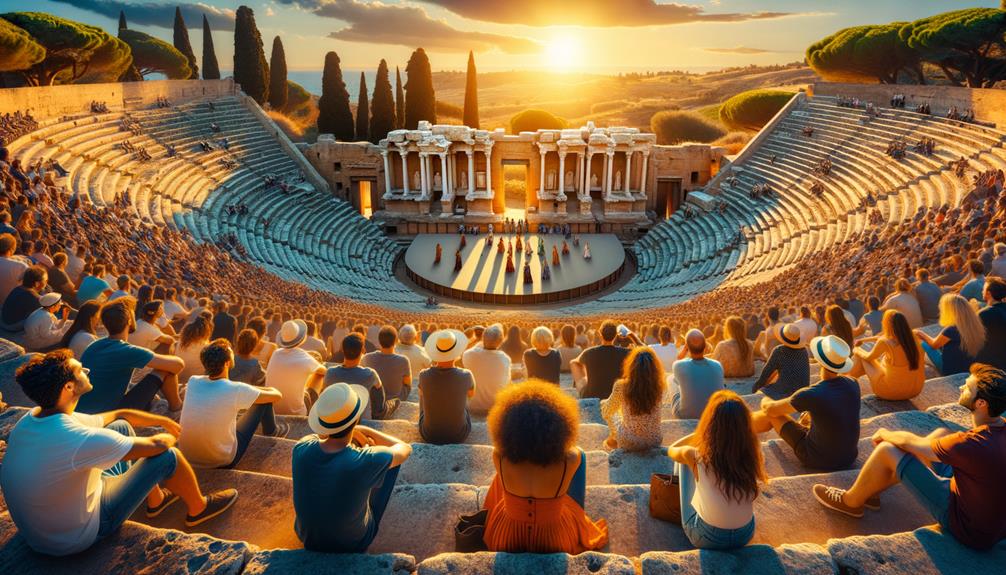
Ready to soak up some insider tips for your visit to the Siracusa Greek Theatre? Let's dive into some unique experiences that will make your trip truly memorable. Whether you're a history buff or just looking for a different kind of adventure, there are plenty of ways to immerse yourself in this ancient wonder.
Consider a private guided tour for a more personalized experience. Limited to just 15 people, these tours allow you to get up close and personal with the theatre's stunning architecture and rich history. You can ask all the questions you want, take your time at the most intriguing spots, and really enjoy every moment.
For a broader adventure, think about taking a day trip from Taormina or Catania. These trips cover not just the Greek Theatre but also Neapolis Archaeological Park, the charming island of Ortigia, and the Baroque beauty of Noto.
Here are some options to think about:
- Private guided tour: Get a deep dive with personalized attention.
- Day trips from Taormina and Catania: Broader cultural experience.
- Private walking tours: A tailored, intimate look at the theatre and its surroundings.
- Group tours: Perfect for meeting other history lovers.
Each choice offers a unique way to appreciate the timeless beauty of Siracusa.
Frequently Asked Questions
What Is the Theatre Greco in Siracusa?
Imagine stepping back into ancient times—the Theatre Greco in Siracusa is a breathtaking 5th-century B.C. Greek theater, carved directly into Temenite Hill. It still resonates with the plays and performances from centuries past.
What Should I Wear to the Greek Theater?
If you're heading to the Greek Theater, go for comfortable and light clothing. A breezy dress or relaxed jeans with a t-shirt works great. Don't forget a hat and sunglasses to shield yourself from the sun, and wear comfy shoes since you might be walking around a lot. The key is to feel good and enjoy the experience!
What Is the Most Beautiful Greek Theatre?
Imagine a stage carved into a hillside, blending perfectly with the natural surroundings. For me, the Siracusa Greek Theatre stands out as the most beautiful. Its timeless architecture and stunning views set it apart from the rest.
Are There Any Greek Theatres Left?
Yes, there are still Greek theatres around. I've visited quite a few, like Epidaurus and Delphi in Greece. These ancient sites, set into the landscape, are full of history and culture, giving us a peek into the grandeur of the past.



